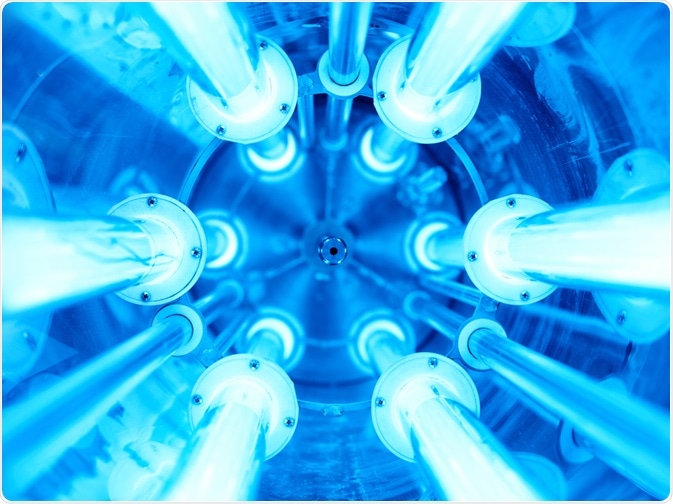The disinfection and sterilization of transmission routes of pathogens are key infection control procedures. These measures kill any microbes present, thereby making the environment cleaner and safer for human use and occupancy. Whilst there are many ways of disinfecting an environment, one method that has been in use for over a century is ultraviolet (UV) light sterilization

Image Credit: Sergey Ryzhov / Shutterstock.com
History of UV sterilization
The use of UV light as a method to sterilize areas and reduce the transmission of pathogens was first proposed in 1878 by Arthur Downes and Thomas P. Blunt. Soon after, the first recorded use of UV light as a disinfection agent was reported in Marseilles, France, in 1910, where this method was used to sterilize drinking water in a prototype plant.
By the 1950s UV water treatment was in use in Switzerland and Austria. By 1985, there were 1,500 UV water treatment plants in operation in Europe. By 2001, this number rose to 6,000 UV water treatment plants that were in use in Europe.
Today, UV light is widely used in hospitalization settings as a sterilization agent for rooms and surfaces. As the use of UV light has become increasingly popular for disinfection purposes, ultraviolet germicidal irradiation (UVGI) systems have also gotten much cheaper.
There has been a renewed interest in the application of UV light for sterilizing rooms and air filtration systems due to the ongoing coronavirus disease 2019 (COVID-19) pandemic.
How it works
UV light is electromagnetic radiation that has a wavelength longer than X-Rays but shorter than visible light. UV light is categorized into different wavelengths, including UV-C, which is short-wavelength UV light that is often referred to as “germicidal” UV.
Between the wavelengths of 200 and 300 nanometers (nm), which is where UV-C operates, nucleic acids in a microbe are disrupted. The nucleic acids absorb the UV-C light, thus resulting in pyrimidine dimers that disrupt the nucleic acids’ ability to replicate or express necessary proteins. This leads to cell death in bacteria and inactivation in viruses.
Germicidal UV lamps are the primary method of application. There are several different types of UV lamps that are currently in use, which include:
- Low-pressure mercury lamps (emitting UV light at 253 nm.)
- Ultraviolet light-emitting diodes (UV-C LEDs), which emit selectable wavelengths between 255 and 280 nm.
- Pulsed-xenon lamps, which emit a wide spectrum of UV light (peak emission is near 230 nm.)
UVGI systems can be installed in enclosed spaces where the constant flow of air or water ensures high levels of exposure. Effectiveness relies on many factors, including the quality and type of equipment uses, the duration of exposure, wavelength and intensity of UV, the presence of protective particles, and the microorganism's ability to withstand UV light. The effectiveness of UVGI systems can also be determined by something as simple as dust on the bulb; therefore, equipment must be regularly cleaned and replaced to ensure its efficacy for sterilization procedures.
There are several advantages and disadvantages associated with UV sterilization processes. In the case of water sterilization, UV will provide superior disinfection without the use of chlorine; however, UVGI-treated water is prone to reinfection. There are also safety concerns, as UV light is harmful to most living organisms and unwanted exposure to UV light can cause sunburns and an increased risk of certain cancers in humans. Other safety concerns include the risk of vision impairment.
Microorganisms such as fungal spores, mycobacteria, and environmental organisms are harder to kill with UVGI systems as compared to bacteria and viruses. While this may be true, UVGI systems that emit high doses of UV light can still be used to remove fungal contaminants from air conditioning systems. Historically, UV light has been used to kill tuberculosis and has recently been used to prevent hospital-based outbreaks of drug-resistant bacteria such as methicillin-resistant Staphylococcus aureus (MRSA).
Using UV light to fight COVID-19
How Ultraviolet Light Could Help Stop The Spread Of Coronavirus
Since early 2020, COVID-19, which is caused by the highly transmissible severe acute respiratory syndrome coronavirus 2 (SARS-CoV-2), has infected over 203 million people worldwide and caused the deaths of more than 4.3 million. Mandated mask-wearing and social distancing measures have been implemented in most countries worldwide in an effort to mitigate the spread of SARS-CoV-2; however, several other methods have also been employed in desperate attempts to gain control of the pandemic.
UV disinfection and sterilization measures have received renewed interest for the disinfection of spaces since the start of the pandemic. UV-C and, to a lesser extent, UV-A, and UV-B radiation have all been shown to inactivate SARS-CoV-2. However, there remains insufficient evidence on the effectiveness of UV-C radiation in mitigating the spread of SARS-CoV-2. This is due to the limited amount of published data on the duration, wavelength, and dose of UV radiation that is needed to inactivate SARS-CoV-2.
SARS-CoV-2 is a respiratory virus that is primarily spread by infected droplets of air expelled from symptomatic or asymptomatic carriers. This has led to a burgeoning market in UV-C sterilization equipment including sanitizing tunnels, UV-C air conditioning and purifying systems, as well as hand dryers that include UV lamps.
Despite their potential utility, these systems do not replace proven controls such as mask-wearing and social distancing. Rather, UV-C systems can act as an extra layer of defense against SARS-CoV-2.
Conclusion
UV light is an effective sterilization measure against a wide range of different microorganisms that are present within the environment. The use of UV sterilizing equipment is becoming more widespread, particularly in reaction to the ongoing COVID-19 pandemic. It is therefore likely that this industry will continue to grow over the coming years.
References
Last Updated: Aug 9, 2021